It's nearly a meter long and engraved with 100 green dragons. It's double edged, sharp at the tip and can cut through iron as if it were mud. It's the legendary Green Destiny Sword (
But few know that the birthplace of this exquisite sword is a fishing village in Kaohsiung County, Taiwan. Kuo Chang-shi (
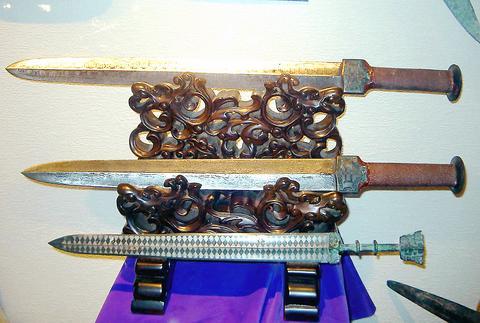
PHOTO: YU SEN-LUN, TAIPEI TIMES
Besides Green Destiny, he has made nearly 400 swords, machetes and spears, such as the double-edged curved ax (
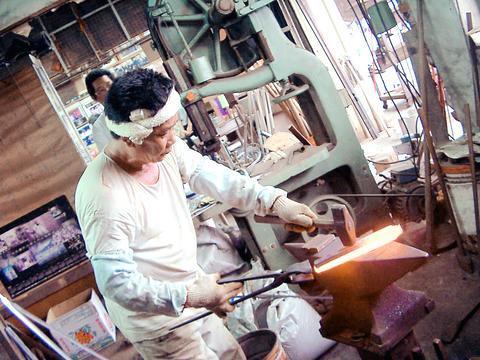
PHOTO: YU SEN-LUN, TAIPEI TIMES
Kuo is not just a maker of film props. He is the owner of Shin Da Arts Sword Store (興達刀舖) and a collector of swords and knives. His Kuo Chang-shi Arts Swords Museum (郭常喜藝術兵器文物館) opened early this year.
Kuo's neighbors from the small fishing of Shin Da call him master Ah-shi (
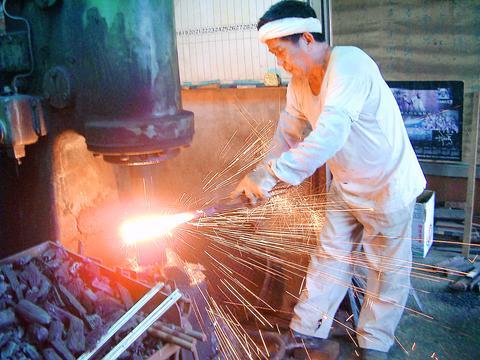
PHOTO: YU SEN-LUN, TAIPEI TIMES
A third-generation blacksmith, Kuo learnt his skills at the age of 13. Now that he's 47 years old, he's still the only full-time worker at his sword-making factory. Every day he works by the forge sweating in the 700°C temperatures. Kuo said a good sword should be forged over 100 times, sometimes in temperatures as high as 1300°C.
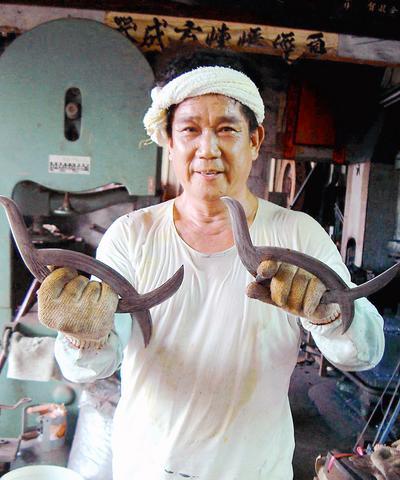
PHOTO: YU SEN-LUN, TAIPEI TIMES
After taking up his father's blacksmith shop in his 20s, Kuo soon became famous in south Taiwan for his knife-making skills. He is one of the few workers who is able to produce full sets of Taoist traditional weapons used in local temple
ceremonies.
His love of ancient swords and knives then prompted him to go to Japan for eight years and learn sword making, especially the multiple-layered steel wrapping technique that he developed and which dates back to the Warring States period (403 to 221BC.). The blacksmith first prepares eight layers of steel and iron, with the steel inside and iron outside (as iron is softer than steel). Then the eight layers are folded together to become a bar. Then it is folded again to create 16 layers, then 32, then 64, and so on up to a 1,000 layers. Kuo said swords or knives made in this way are strong yet supple and cut like a razor. To prove it, he chopped a 5cm-thick steel rope in half and one of the pieces flew out the side of the house.
It takes strength, perseverance and devotion to become a sword maker and Kuo delights in talking about the stories of Gan-jiang (
A king from the Wu state ordered the couple to make two superior swords in three months. But limited by technique, the two found it hard to forge pure steel. In desperation, Mo, the wife, then threw herself into the forge.
As human bones can filter out impurities from iron and steel great swords were eventually made. And the swords were named after the couple. "That was the first sword made with a steel-wrapping technique in history," Kuo said.
Kuo said he had been collecting swords for over 40 years and boasted the newly opened Kuo Chang-shi Art Swords Museum now has more than 1,0000 ancient swords and knives. Kuo has also reproduced some of the ancient swords that had been lost. About 80 percent of the swords in the museum were re-created by Kuo, including the Green Destiny. There are also Japanese samurai swords and swords used by Taiwanese Aboriginals.
Making a Green Destiny sword takes about two days, Kuo said, and costs around NT$100,000 -- but this price has not deterred politicians and celebrities from coveting the sword.
Having been a blacksmith and having finally owned a museum of his own, Kuo's only unfulfilled goal is to find a disciple to pass down all his skills and techniques.
"None of my kids wants to work under the heat," he said. "Besides, sword making takes superb skills and it is hard to find young people who not only can endure the heat and are hard-working, but also have skillful hands," he said.
"I once trained a young man for four years but all he could make was a fine farming tool. So he gave up," Kuo said.
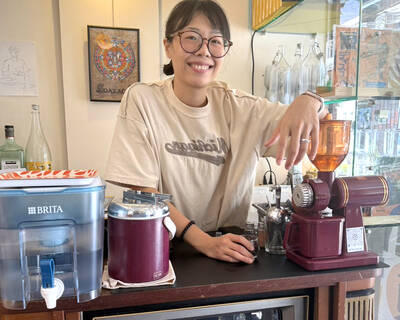
Cheng Ching-hsiang (鄭青祥) turned a small triangle of concrete jammed between two old shops into a cool little bar called 9dimension. In front of the shop, a steampunk-like structure was welded by himself to serve as a booth where he prepares cocktails. “Yancheng used to be just old people,” he says, “but now young people are coming and creating the New Yancheng.” Around the corner, Yu Hsiu-jao (饒毓琇), opened Tiny Cafe. True to its name, it is the size of a cupboard and serves cold-brewed coffee. “Small shops are so special and have personality,” she says, “people come to Yancheng to find such treasures.” She

Late last month Philippines Foreign Affairs Secretary Theresa Lazaro told the Philippine Senate that the nation has sufficient funds to evacuate the nearly 170,000 Filipino residents in Taiwan, 84 percent of whom are migrant workers, in the event of war. Agencies have been exploring evacuation scenarios since early this year, she said. She also observed that since the Philippines has only limited ships, the government is consulting security agencies for alternatives. Filipinos are a distant third in overall migrant worker population. Indonesia has over 248,000 workers, followed by roughly 240,000 Vietnamese. It should be noted that there are another 170,000
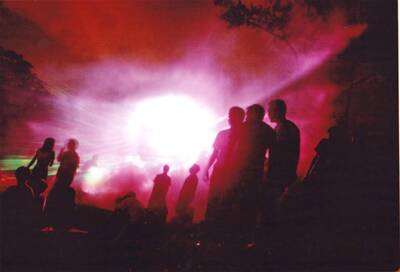
In July of 1995, a group of local DJs began posting an event flyer around Taipei. It was cheaply photocopied and nearly all in English, with a hand-drawn map on the back and, on the front, a big red hand print alongside one prominent line of text, “Finally… THE PARTY.” The map led to a remote floodplain in Taipei County (now New Taipei City) just across the Tamsui River from Taipei. The organizers got permission from no one. They just drove up in a blue Taiwanese pickup truck, set up a generator, two speakers, two turntables and a mixer. They
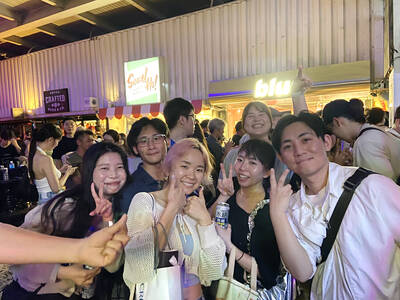
Hannah Liao (廖宸萱) recalls the harassment she experienced on dating apps, an experience that left her frightened and disgusted. “I’ve tried some voice-based dating apps,” the 30-year-old says. “Right away, some guys would say things like, ‘Wanna talk dirty?’ or ‘Wanna suck my d**k?’” she says. Liao’s story is not unique. Ministry of Health and Welfare statistics show a more than 50 percent rise in sexual assault cases related to online encounters over the past five years. In 2023 alone, women comprised 7,698 of the 9,413 reported victims. Faced with a dating landscape that can feel more predatory than promising, many in